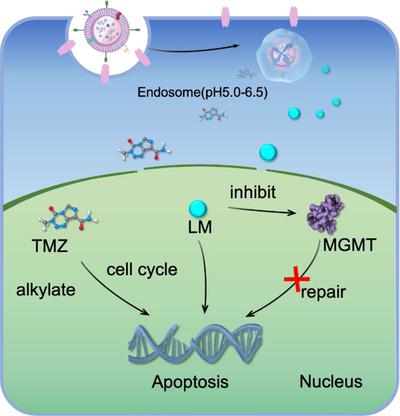当前位置:
X-MOL 学术
›
Adv. Therap.
›
论文详情
Our official English website, www.x-mol.net, welcomes your
feedback! (Note: you will need to create a separate account there.)
A Biomimetic Nanomedicine Targets Orthotopic Glioblastoma by Combinatorial Co-Delivery of Temozolomide and a Methylguanine-DNA Methyltransferase Inhibitor
Advanced Therapeutics ( IF 3.7 ) Pub Date : 2022-09-10 , DOI: 10.1002/adtp.202200095 Yibin Wang 1, 2 , Yajing Sun 1, 2 , Nan Geng 1, 2 , Meng Zheng 1, 2 , Yan Zou 1, 2, 3 , Bingyang Shi 1, 2, 3
Advanced Therapeutics ( IF 3.7 ) Pub Date : 2022-09-10 , DOI: 10.1002/adtp.202200095 Yibin Wang 1, 2 , Yajing Sun 1, 2 , Nan Geng 1, 2 , Meng Zheng 1, 2 , Yan Zou 1, 2, 3 , Bingyang Shi 1, 2, 3
Affiliation

|
Glioblastoma (GBM) is the most aggressive intracranial tumor that occurs in the central nervous system (CNS) and has no effective treatment due to the fact of drug resistance. To combat drug resistance, TMZ is generally administrated in combination with other chemotherapeutic drugs. Unfortunately, drug combinations used to date only show modest improvements in anti-tumor effects and have increased toxicity. Herein, an ApoE peptide decorated GBM cancer cell membrane camouflaged nanomedicine (AMNPs@TMZ+LM) to specifically co-deliver TMZ and the MGMT inhibitor lomeguatrib (LM) for combinatorial GBM treatment is developed. Incorporation of LM not only effectively suppresses the repair of damaged DNA, but also inhibits tumor cell proliferation by inducing cell cycle arrest. Importantly, this biomimetic nanomedicine achieves high BBB penetration and enhances sensitivity to both TMZ-resistant (U251-TR) and GBM stem cells (GSCs). Notably, AMNPs@TMZ+LM results in significant inhibition of the growth of orthotopically implanted U251-TR tumor in mice. In comparison, treatment with single drug loaded nanomedicines results in compromised anti-GBM effects. Histological analyses and blood parameter studies show good biocompatibility of the nanomedicine. Hence, this biomimetic nanomedicine provides a potential new approach to overcome the limitations of current GBM chemotherapy regimens by co-delivery of TMZ and the MGMT inhibitor LM.
中文翻译:

一种仿生纳米药物通过组合联合递送替莫唑胺和甲基鸟嘌呤-DNA 甲基转移酶抑制剂靶向原位胶质母细胞瘤
胶质母细胞瘤 (GBM) 是发生在中枢神经系统 (CNS) 中最具侵袭性的颅内肿瘤,由于耐药性,目前尚无有效治疗方法。为了对抗耐药性,TMZ 通常与其他化疗药物联合使用。不幸的是,迄今为止使用的药物组合仅在抗肿瘤作用方面表现出适度的改善,并且增加了毒性。在此,开发了一种 ApoE 肽修饰的 GBM 癌细胞膜伪装纳米药物 (AMNPs@TMZ+LM),用于特异性地共同递送 TMZ 和 MGMT 抑制剂 lomeguatrib (LM),用于组合 GBM 治疗。LM 的掺入不仅有效抑制受损 DNA 的修复,而且还通过诱导细胞周期停滞来抑制肿瘤细胞增殖。重要的,这种仿生纳米药物可实现高 BBB 渗透并增强对 TMZ 抗性 (U251-TR) 和 GBM 干细胞 (GSC) 的敏感性。值得注意的是,AMNPs@TMZ+LM 可显着抑制小鼠原位植入的 U251-TR 肿瘤的生长。相比之下,用单一载药纳米药物治疗会导致抗 GBM 作用减弱。组织学分析和血液参数研究表明纳米药物具有良好的生物相容性。因此,这种仿生纳米药物提供了一种潜在的新方法,通过共同递送 TMZ 和 MGMT 抑制剂 LM 来克服当前 GBM 化疗方案的局限性。相比之下,用单一载药纳米药物治疗会导致抗 GBM 作用减弱。组织学分析和血液参数研究表明纳米药物具有良好的生物相容性。因此,这种仿生纳米药物提供了一种潜在的新方法,通过共同递送 TMZ 和 MGMT 抑制剂 LM 来克服当前 GBM 化疗方案的局限性。相比之下,用单一载药纳米药物治疗会导致抗 GBM 作用减弱。组织学分析和血液参数研究表明纳米药物具有良好的生物相容性。因此,这种仿生纳米药物提供了一种潜在的新方法,通过共同递送 TMZ 和 MGMT 抑制剂 LM 来克服当前 GBM 化疗方案的局限性。
更新日期:2022-09-10
中文翻译:

一种仿生纳米药物通过组合联合递送替莫唑胺和甲基鸟嘌呤-DNA 甲基转移酶抑制剂靶向原位胶质母细胞瘤
胶质母细胞瘤 (GBM) 是发生在中枢神经系统 (CNS) 中最具侵袭性的颅内肿瘤,由于耐药性,目前尚无有效治疗方法。为了对抗耐药性,TMZ 通常与其他化疗药物联合使用。不幸的是,迄今为止使用的药物组合仅在抗肿瘤作用方面表现出适度的改善,并且增加了毒性。在此,开发了一种 ApoE 肽修饰的 GBM 癌细胞膜伪装纳米药物 (AMNPs@TMZ+LM),用于特异性地共同递送 TMZ 和 MGMT 抑制剂 lomeguatrib (LM),用于组合 GBM 治疗。LM 的掺入不仅有效抑制受损 DNA 的修复,而且还通过诱导细胞周期停滞来抑制肿瘤细胞增殖。重要的,这种仿生纳米药物可实现高 BBB 渗透并增强对 TMZ 抗性 (U251-TR) 和 GBM 干细胞 (GSC) 的敏感性。值得注意的是,AMNPs@TMZ+LM 可显着抑制小鼠原位植入的 U251-TR 肿瘤的生长。相比之下,用单一载药纳米药物治疗会导致抗 GBM 作用减弱。组织学分析和血液参数研究表明纳米药物具有良好的生物相容性。因此,这种仿生纳米药物提供了一种潜在的新方法,通过共同递送 TMZ 和 MGMT 抑制剂 LM 来克服当前 GBM 化疗方案的局限性。相比之下,用单一载药纳米药物治疗会导致抗 GBM 作用减弱。组织学分析和血液参数研究表明纳米药物具有良好的生物相容性。因此,这种仿生纳米药物提供了一种潜在的新方法,通过共同递送 TMZ 和 MGMT 抑制剂 LM 来克服当前 GBM 化疗方案的局限性。相比之下,用单一载药纳米药物治疗会导致抗 GBM 作用减弱。组织学分析和血液参数研究表明纳米药物具有良好的生物相容性。因此,这种仿生纳米药物提供了一种潜在的新方法,通过共同递送 TMZ 和 MGMT 抑制剂 LM 来克服当前 GBM 化疗方案的局限性。











































 京公网安备 11010802027423号
京公网安备 11010802027423号